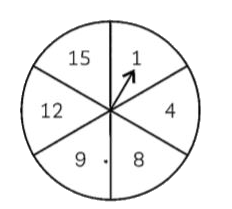Three squares of Chess board are selected at random. Find the probability of getting 2 squares of one colour and other of a different colour.
To solve the problem of finding the probability of selecting 2 squares of one color and 1 square of a different color from a chessboard, we can follow these steps:
Step 1: Understand the Chessboard Configuration
A standard chessboard consists of 64 squares, with 32 squares colored black and 32 squares colored white.
Step 2: Calculate Total Ways to Select 3 Squares
To find the total number of ways to select 3 squares from 64 squares, we use the combination formula:
Total ways=(643)
Step 3: Calculate Favorable Outcomes
We need to find the number of favorable outcomes where 2 squares are of one color and 1 square is of a different color. There are two scenarios:
1. Scenario 1: 2 squares are black and 1 square is white.
- The number of ways to choose 2 black squares from 32 black squares is:
(322)
- The number of ways to choose 1 white square from 32 white squares is:
(321)
- Therefore, the total ways for this scenario is:
(322)×(321)
2. Scenario 2: 2 squares are white and 1 square is black.
- The number of ways to choose 2 white squares from 32 white squares is:
(322)
- The number of ways to choose 1 black square from 32 black squares is:
(321)
- Therefore, the total ways for this scenario is:
(322)×(321)
Step 4: Combine the Favorable Outcomes
The total number of favorable outcomes for both scenarios is:
Total favorable outcomes=((322)×(321))+((322)×(321))=2×((322)×(321))
Step 5: Calculate the Probability
The probability P of selecting 2 squares of one color and 1 square of a different color is given by the ratio of favorable outcomes to total outcomes:
P=Total favorable outcomesTotal ways=2×((322)×(321))(643)
Step 6: Simplify the Expression
Now, we can calculate the values:
- (322)=32×312=496
- (321)=32
- (643)=64×63×623!=64×63×626
Substituting these values into the probability formula gives:
P=2×(496×32)64×63×626
Step 7: Final Calculation
Calculating the numerator and denominator:
1. Numerator:
2×496×32=31712
2. Denominator:
64×63×626=39712
Thus, the probability simplifies to:
P=3171239712=1621
Final Answer
The probability of selecting 2 squares of one color and 1 square of a different color is:
1621
A standard chessboard consists of 64 squares, with 32 squares colored black and 32 squares colored white.
To find the total number of ways to select 3 squares from 64 squares, we use the combination formula:
We need to find the number of favorable outcomes where 2 squares are of one color and 1 square is of a different color. There are two scenarios:
- The number of ways to choose 2 black squares from 32 black squares is:
(322)
- The number of ways to choose 1 white square from 32 white squares is:
(321)
- Therefore, the total ways for this scenario is:
(322)×(321)
- The number of ways to choose 2 white squares from 32 white squares is:
(322)
- The number of ways to choose 1 black square from 32 black squares is:
(321)
- Therefore, the total ways for this scenario is:
(322)×(321)
The total number of favorable outcomes for both scenarios is:
Total favorable outcomes=((322)×(321))+((322)×(321))=2×((322)×(321))
The probability P of selecting 2 squares of one color and 1 square of a different color is given by the ratio of favorable outcomes to total outcomes:
Now, we can calculate the values:
- (322)=32×312=496
- (321)=32
- (643)=64×63×623!=64×63×626
Calculating the numerator and denominator:
2×496×32=31712
2. Denominator:
64×63×626=39712
The probability of selecting 2 squares of one color and 1 square of a different color is:
Topper's Solved these Questions
Similar Questions
Knowledge Check
Three squares of a chessboard are chosen at random. the probability that two are of one colour and one of another is :
A67992B1621C3132Dnone of theseThree squares of a chessboard are chosen at random. the probability that two are of one colour and one of another is :
A67992B1621C3132Dnone of theseTwo small squares on a chess board are choosen at random. Find the probability that they have a common side:
A112B118C215D314
Find the probability of selecting 2 squares in chessboard who have a side in common
View SolutionFour small squares on a chessboard are selected at random. The probability that they form a square of the size 2×2 is _______.
View SolutionIf the squares of a 8×8 chess board are painted either red and black at random .The probability that not all squares is any alternating in colour is
View SolutionOne card is drawn from a well shuffled deck of cards . Find the probability of getting a king of red colour .
View SolutionAn urn contains three white, six red and four black balls. Two balls are selected at random. What is the probability that one ball is red and other is white, given that they are of different colour ?
View Solution

